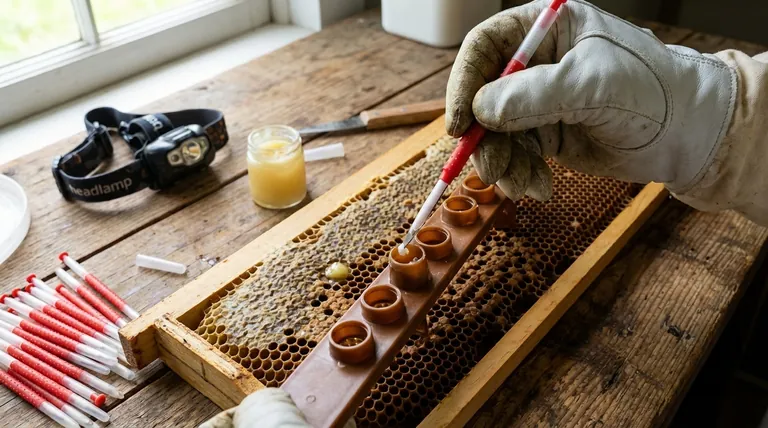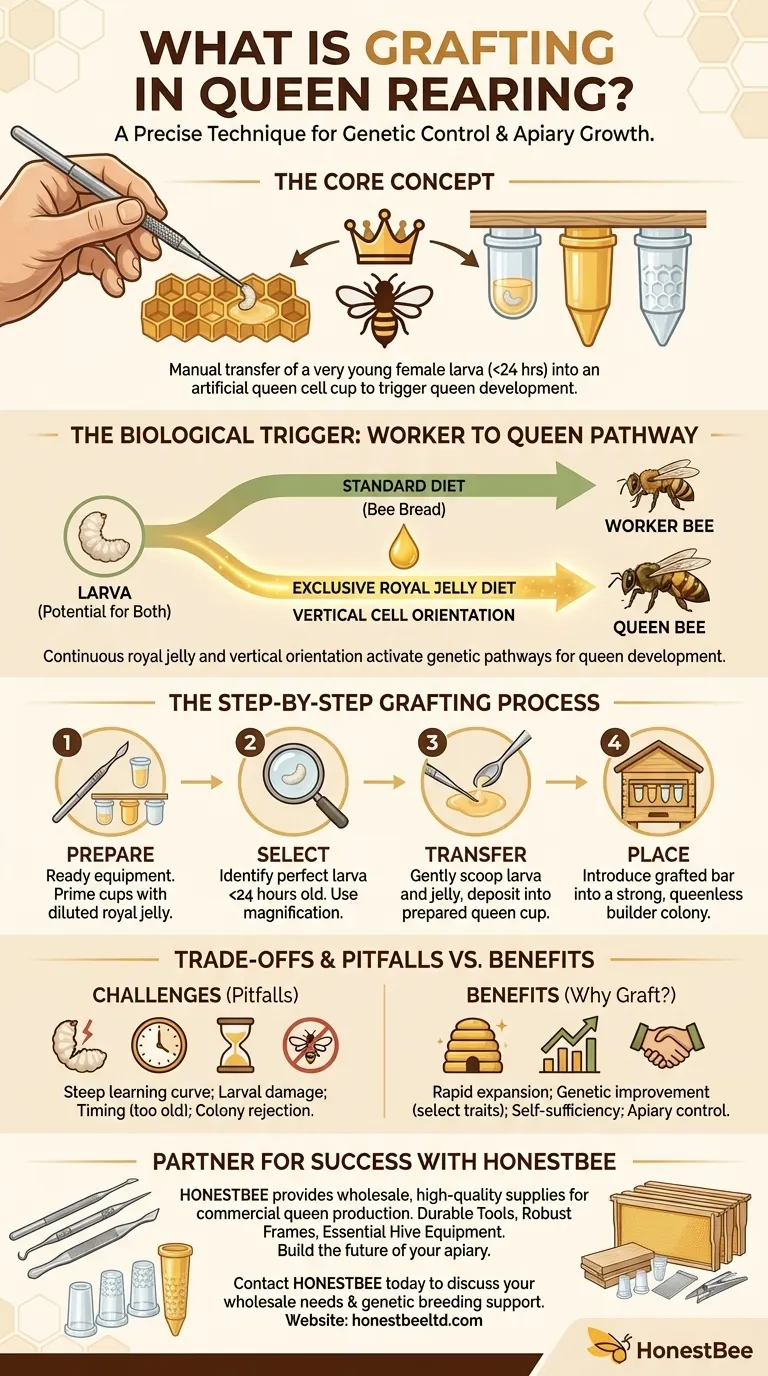At its core, queen grafting is the manual transfer of a very young female larva from a standard worker cell into an artificial queen cell cup. This single action, when done correctly, tricks a colony into feeding the larva a diet of pure royal jelly, which activates the genetic pathways that transform it from a potential worker bee into a new queen.
Grafting is more than a technical procedure; it is the beekeeper's primary tool for directing the genetic future of an apiary. By selecting larvae from specific hives, you are intentionally breeding for desirable traits like gentleness, disease resistance, and honey production.

The Biological Trigger: From Worker to Queen
The success of grafting hinges on manipulating a bee colony's natural instincts. It works because all female larvae have the potential to become either a worker or a queen in their first few days of life.
The Deciding Factor: Royal Jelly
Every larva receives royal jelly for the first couple of days. However, larvae destined to be workers are soon switched to a diet of "bee bread"—a mix of pollen and nectar. A larva that is continuously fed a diet exclusively of royal jelly will develop into a queen. Grafting ensures this happens on your terms.
The Environmental Cue: Cell Orientation
Worker bees build queen cells vertically, pointing downwards. By placing a larva into a man-made, vertically-oriented queen cup, you are sending a powerful signal to the nurse bees that this larva is a queen-in-the-making, prompting them to feed it accordingly.
The Goal: Selecting for Ideal Genetics
Grafting is not random. The beekeeper intentionally selects larvae from a "breeder queen" colony—one that exhibits the most desirable traits. This allows for the targeted propagation of strong genetics throughout the entire apiary, a level of control impossible with natural queen replacement.
The Step-by-Step Grafting Process
While the concept is simple, the execution requires precision, a steady hand, and the right conditions.
Step 1: Prepare the Equipment
Before you begin, your grafting tool, cell cups, and cell bars must be ready. Many beekeepers "prime" the empty queen cups with a tiny drop of diluted royal jelly to create a welcoming bed for the larva.
Step 2: Identify the Perfect Larva
This is the most critical step. You must select a larva that is less than 24 hours old. These larvae are incredibly small, often just barely visible to the naked eye, and will be floating in a pool of royal jelly. Using magnification and a headlamp is highly recommended.
Step 3: Execute the Transfer
Gently slide the tip of your grafting tool underneath the larva and the royal jelly it rests in. Carefully scoop it up without rolling or damaging it. With a delicate rolling motion of your wrist, deposit the larva into the bottom of the prepared queen cup.
Step 4: Place Cells in the Builder Colony
Once a bar of cells is grafted, it must be placed promptly into a "cell builder" colony. This is a strong, populous, and queenless colony that is biologically primed to accept and raise new queens. They will immediately begin feeding the grafted larvae.
Understanding the Trade-offs and Common Pitfalls
Grafting is a powerful technique, but it is not without its challenges. Understanding these limitations is key to success.
The Steep Learning Curve
Grafting is a delicate skill that requires practice. Your first attempts may have a low success rate. Many beekeepers practice on larger, more expendable drone larvae to develop muscle memory before moving to valuable worker larvae.
Risk of Larval Damage
The larvae are exceptionally fragile. Touching them directly with the tool, letting them dry out, or jostling them can easily cause fatal damage. The entire motion must be a gentle scoop of the larva and its bed of royal jelly.
Timing is Everything
Grafting a larva that is too old (over 36 hours) is a common mistake. While the bees may still raise a queen, she will be of inferior quality because she missed a crucial period of the royal jelly diet. Success depends on identifying the absolute youngest larvae.
Colony Acceptance is Not Guaranteed
Simply performing a perfect graft is not enough. The cell builder colony must be in the correct state to accept the cells. If it is not sufficiently strong, queenless, or well-fed, the bees may ignore or destroy your grafted cells.
Making the Right Choice for Your Apiary
Grafting is an advanced technique, but its benefits are significant for the serious beekeeper.
- If your primary focus is rapid expansion: Grafting is the most efficient method for producing a large number of queens, allowing you to make many splits and grow your apiary quickly.
- If your primary focus is genetic improvement: This technique gives you direct control to breed from your best stock, consistently improving the health, temperament, and productivity of your hives.
- If your primary focus is self-sufficiency: Mastering grafting frees you from the need to purchase queens, giving you complete control over your operation's timeline and stock.
Mastering this skill transforms you from a bee-keeper into a bee-breeder, giving you ultimate control over your apiary's destiny.
Summary Table:
| Key Aspect | Description |
|---|---|
| Core Action | Transferring a young larva (<24 hours old) from a worker cell to an artificial queen cup. |
| Primary Goal | Direct genetic selection for desirable traits from a chosen breeder queen. |
| Biological Trigger | Continuous feeding of royal jelly, triggered by the vertical cell orientation. |
| Ideal For | Beekeepers focused on rapid expansion, genetic improvement, and operational self-sufficiency. |
Ready to Elevate Your Queen Rearing?
Mastering grafting requires precision tools and reliable equipment. At HONESTBEE, we supply commercial apiaries and beekeeping equipment distributors with the high-quality, wholesale-focused supplies needed for successful grafting and large-scale queen production.
We provide the tools for your success:
- Durable Grafting Tools & Cell Cups for precise, damage-free larval transfers.
- Robust Cell Bars & Frame Kits to build strong, accepted queen cells.
- Essential Hive Management Equipment to maintain your powerful cell builder colonies.
Let's build the future of your apiary together.
Contact HONESTBEE today to discuss your wholesale needs and how our equipment can support your genetic breeding programs.
Visual Guide

Related Products
- Plastic Chinese Queen Grafting Tool for Bee Queen Rearing
- HONESTBEE Advanced Ergonomic Stainless Steel Hive Tool for Beekeeping
- Professional 3-Bar Frame Grip with Integrated Hive Tool
- No Grafting Queen Rearing Kit: System for Royal Jelly Production and Queen Rearing
- Professional Dual-End Stainless Steel Hive Tool for Beekeeping
People Also Ask
- What is the purpose of a queen grafting tool in beekeeping? Master Larva Transfer for Selective Breeding
- What environmental conditions are optimal for grafting? Master Queen Rearing with Perfect Hive-Like Conditions
- How should the selected brood frame be prepared for grafting? A Step-by-Step Guide to Protect Larval Viability
- What are the steps involved in the grafting process? Master Queen Rearing for Your Apiary
- What are the steps involved in using a queen grafting tool? A Guide to Successful Queen Rearing



















